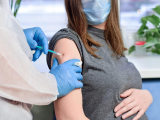Aug 8, 2006 (CIDRAP News) – Two national groups of infectious disease experts urged the White House to make the development of vaccines the most important element in the nation's pandemic influenza plan.
In a press release today, the Infectious Diseases Society of America (IDSA) and the Society for Healthcare Epidemiology of America (SHEA) detailed the letter they sent to Frances Townsend, Assistant to the President for Homeland Security and Counterterrorism, on Aug 4 responding to the White House's National Strategy for Pandemic Influenza, released in May.
The government's 228-page pandemic plan explains the steps that federal agencies will take in the event of a pandemic. It spells out 300 government responses to a pandemic and outlines what pandemic planning measures are expected from other groups (see May 3 CIDRAP News article).
The pandemic plan states that vaccines are the best way to contain a pandemic and that the government is attempting to stockpile enough existing, or prepandemic, H5N1 vaccine to immunize 20 million people and create a vaccine-manufacturing surge capacity to make enough pandemic vaccine for all Americans within 6 months of a pandemic's start. The government's current supply is only a few million doses.
However, the IDSA and SHEA say a more comprehensive, international approach is needed for vaccine development, and the United States should lead international efforts to develop the new vaccines. "We must do the legwork now so that we can produce and deploy these vaccines were we need them when a pandemic hits," said Martin J. Blaser, MD, president of the IDSA.
New vaccine science and delivery approaches are urgently needed, and vaccine makers must be involved in the process, the two groups said. "There is a need for rapid, transparent, and extensive exchange of scientific information among experts, and a novel systematic approach is needed to speed vaccine development," the groups wrote in their comments to the White House. Strong working relationships with other countries—particularly those in Southeast Asia—will be the keys to detecting novel viruses early enough to develop effective vaccines.
In addressing other parts of the federal pandemic plan, the societies lauded the White House for clearly designating the Department of Health and Human Services as the lead medical responder and the Department of Homeland Security as the operation and resource coordinator.
"But far more work remains to be done at the federal, local, and state levels so that there is clarity about who is in charge of what. When everyone knows their battle stations, things go better," said Blaser.
The two societies also called for:
- Federal guidance on a consistent, unified approach to pandemic preparedness for local authorities
- Regular drills to ensure that pandemic plans work
- An expert panel convened by the Centers for Disease Control and Prevention to scientifically evaluate the effectiveness of existing community mitigation models
- More funding for state, local, and global pandemic planning efforts
See also:
National Strategy for Pandemic Influenza: Implementation Plan
http://georgewbush-whitehouse.archives.gov/homeland/pandemic-influenza-implementation.html
May 3 CIDRAP News article "New US pandemic plan stresses local self-reliance"


















